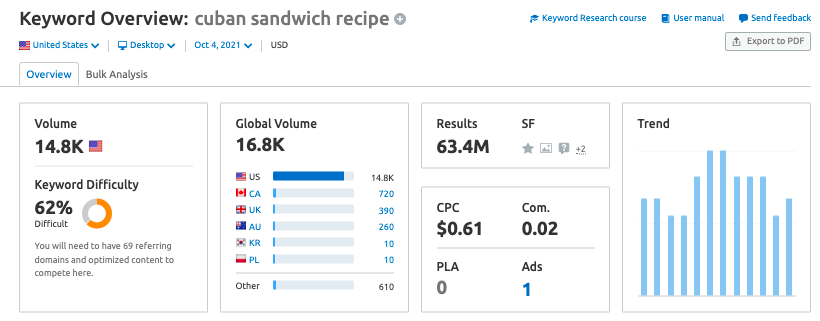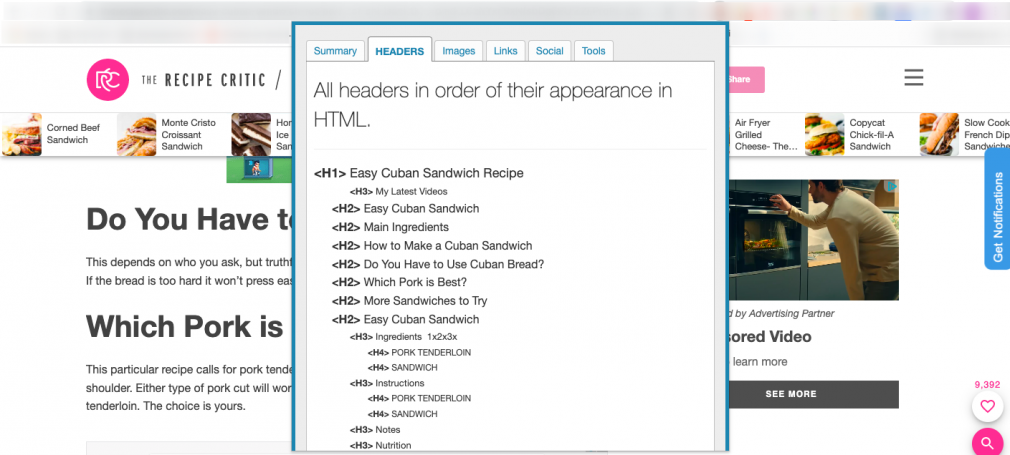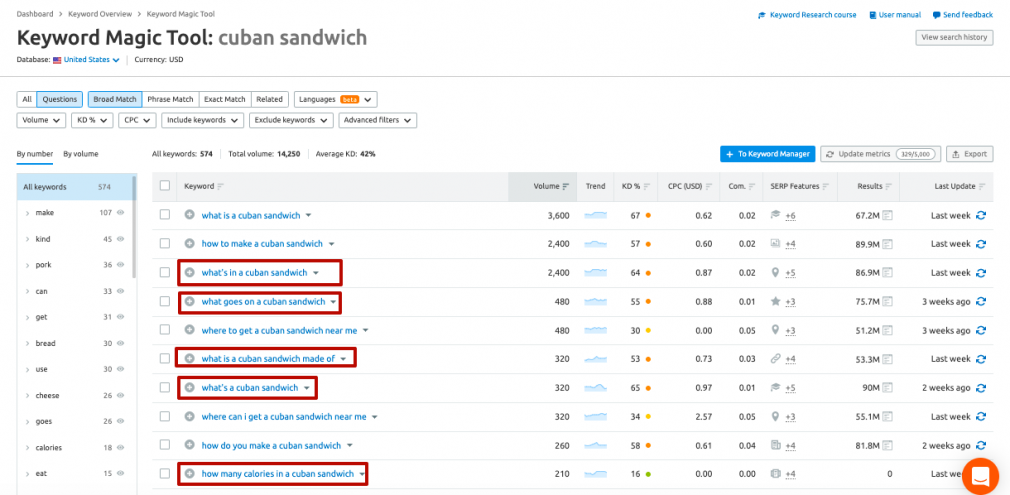As a part of our SEO Reality Show series, we keep telling you our story of how one SEO agency is developing a blog for their bakery client Edelweiss from Florida.
The agency has already chosen the list of impactful topics with a blog research process detailed here, and a website content plan discussed here. Now it’s time to create content! Anyone who has ever tried to convey what end results they want to a third-party or inhouse copywriter knows that this can be a significant challenge. It’s easy to end up on two completely different pages, and even if the content is great, the SEO work may not be.
In order to create for the bakery’s blog not only engaging, but high-ranking content that would rank well, the agency knew they should craft a list of technical specifications for their inhouse copywriters to follow. In this blog post, we’ll show you the example of preparing such a technical content brief for the article topic “How to make a Cuban sandwich”.
Step 1 — Defining the main keyword
The first step is to define the main keyword for the chosen topic. The idea is to choose a keyword with a high potential search volume and a high potential sales intent. In this case, the agency has revealed [Cuban sandwich recipe] as a potentially high-value keyword: it had a lower keyword density and a higher search volume than the [Cuban sandwich] keyword. You can find the detailed process of choosing the main keyword in our past episode about content strategy creation.

Step 2 — Gathering semantics
The next step involves gathering semantics after choosing the main keyword.
In one of our previous episode recaps, we detailed the process of collecting the semantic core for the bakery’s homepage: How to Conduct Semantic SEO Research for an Artisan Bakery.
Collecting the semantic core for a blog article follows a similar pattern and includes the following steps:
- Collecting keywords using keyword research tools. For the bakery’s content, the agency uses Semrush’s Keyword Overview and Keyword Magic Tool
- Analyzing competitor articles to expand the keyword list. There may be a number of relevant secondary keywords which competitors use to show Google that their content is relevant and authoritative. These keywords don’t contain the target keyword, but they perfectly complement the article. So while you might be writing an article on “Cuban sandwich recipe,” you might discover relevant secondary keywords like “best bread for Cuban sandwiches” or “what toppings to add to Cuban sandwiches” that work well with your post.
The agency strongly recommends gathering secondary keyword data and compiling it in a separate column for easy use later on.
Step 3 — Defining the post’s structure
While not all freelance writers or internal writers necessarily need an outline of a blog post’s structure, the agency prefers outlining a post’s structure for third-party writers to ensure that the client receives a very specific end result that will be comparable to top-ranking posts already published.
A solid structure helps to provide the reader with a comprehensive and authoritative answer to their question. It should be easy to follow and make logical sense to the reader. And sometimes, the easiest way to determine what content you should cover starts with checking out what the competition is doing.
The agency uses the following steps when determining what structure the copywriters should follow:
1. Analyzing top search results
In order to determine the most effective base structure for articles quickly, the agency reviewed the articles ranking in the top 10 for the target keyword.
To speed up this process, they use the SEO Meta in 1 Click extension, which you can see below.

This extension displays the full list of headers in order of their appearance in the text, showing what types of headers are used and what the actual titles and subtitles say.
This can tell you what content is covered and how it’s organized, which can give you plenty of inspiration by showing you what your competitors are already doing with their article structures. While it’s important to create your own original content, this can give you a launching point.
2. Selecting suitable articles
When using competitors’ articles to help develop an article’s tentative structure, choosing articles that are relevant to the type of content you want to create is key.
In order to find relevant and quality articles, the agency looked at the following:
- The intent of the article (which in this case is to teach someone how to make a Cuban sandwich)
- The structure of the narrative itself, and whether it’s detailed enough to have all the information needed to deliver on the user’s intent
The agency developed a systematic approach to streamline this process so they could quickly identify relevant articles and use their combined structures for inspiration. They created and utilized the following workflow:
- They opened the first link in the top 10 SERPs
- They looked to make sure it aligns with the intent of “How to make a Cuban sandwich”
- If so, they copied its structure to Google Sheets
- They repeated this process with every other article ranking in the top 10 slots for the target keyword, giving them a full list of subheads that their competition used
- They removed any duplicate titles from the list, creating a single detailed outline
3. FAQ Block
In order to add unique content to help the post rank well, the agency wanted to add a dedicated section featuring questions and answers. This can help the bakery client rank for additional secondary keywords in the SERPs or appear in featured snippets. You can also add FAQPage markup to have these questions displayed as a snippet in search.
To create the FAQ block, the agency used a few tools:
To make the search more efficient, the agency focused the on more general, short-tail keyword “Cuban sandwich.”

Step 4 — Determining the article’s length
To provide word count guidance and parameters to the copywriter, the agency took the following approach, based on their experience and previous successful cases with clients:
- They found articles that were relevant to the intent of teaching users how to make a Cuban sandwich, and that were the approximate average length of the other top-ranking posts
- Copied the text of the top-ranking articles (without comments, ad blocks, or additional site content.)
- Determined the length of these articles individually with any word count tool like https://www.charactercountonline.com/
- Chose the post with the highest word count
- Added 100 words (or around 500 characters) to that total word count
Some agencies will take a different approach; some don’t worry about exact word count or trying to “beat” competing articles’ word counts and instead focus on the content itself. The agency has had good results previously with this particular strategy, so it may be worth testing.
If you want to simplify this process, check out the SEO Content Template tool. It automatically determines the required number of words for your article. When the agency used this tool, the word count was shorter than what they felt would rank well based on relevant top 10 searches.
Step 5 — Creation of the technical content brief
The purpose of a technical content brief is different from your standard content topic brief. It’s focused on the technical specifications the content needs to meet in order to have the best chance at ranking well.
While standard content briefs focus on goal optimization, style guidelines, and topics, the technical brief focuses on keywords, recommended structures, references, and word count. There can be an overlap between the two.
At this stage, the article’s technical specifications are ready and outlined. You can see an example of the final specification prepared by the agency here.
The brief they sent the copywriters included the following fields:
- Topic — A topic from the list prepared during the preparation of the content plan
- Recommended structure — The final structure of the article, which the agency created in the steps above
- Semantic Core — semantic (or “secondary”) keywords
- Freq — The keyword frequency according to Semrush
- Topic Phrases — Additional semantic keywords used by competitors to rank but not including the main keyword; see step 2
- Number of symbols/words — The number of characters without spaces/words
- References — Articles that can be used as a basis for writing content, including internal and non-competing external links
- Comments — The SEO specialist’s comments for the copywriter
- H1 Title
The agency would then receive a final draft, and then have their agency crate the meta description and meta title.
- Meta title
- Meta Description
After compiling a brief, you can send it to a freelance content marketer OR a copywriting service like Semrush Content Marketplace to generate a high-quality draft that can be published on your site.
After receiving ready content from a copywriter the agency will prepare meta tags for their article; you can learn more about how the agency does this for the bakery’s website here.
Next Up
Creating technical briefs and instructions for the copywriter creating your content is an important part of the content creation process. It ensures the client gets the results they want and that all SEO requirements are followed.
In the next episode, we’ll share how the agency audited Edelweiss’ blog to assess its success. Stay tuned ????

